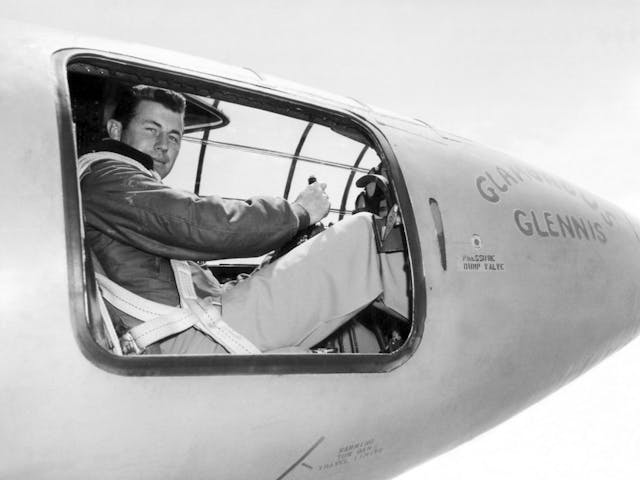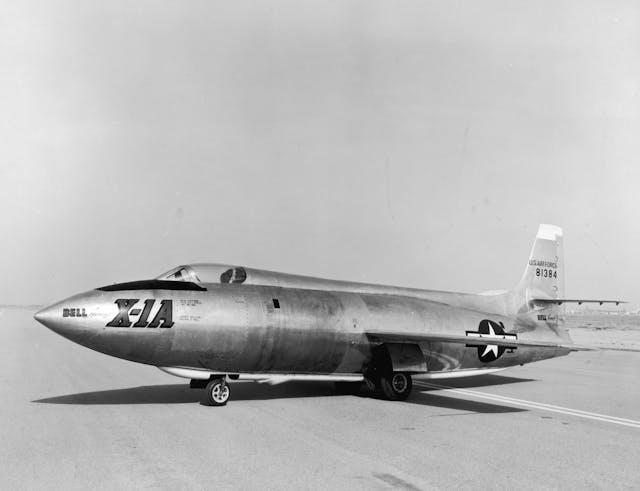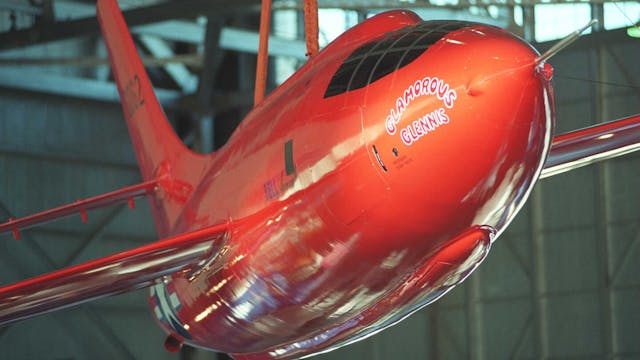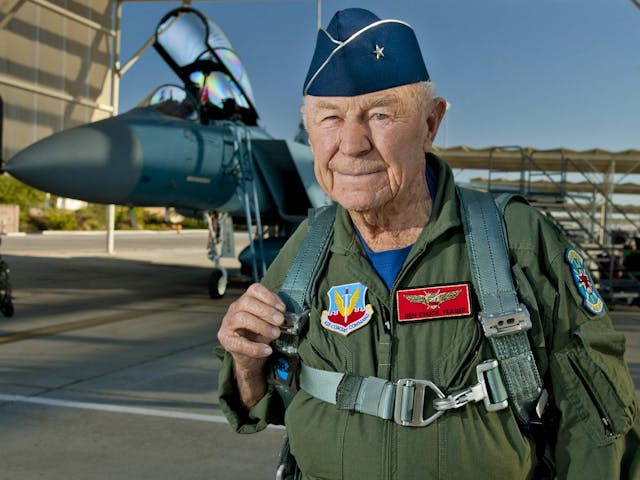75 years ago, test pilot Chuck Yeager went supersonic
“Rules,” Chuck Yeager once said, “are made for people who aren’t willing to make up their own.” Armed with courage, confidence, and the talent to back it up, Yeager continually defied the odds and experts on his way to becoming a legend.
Yeager was already a decorated World War II combat fighter when he volunteered to test-fly the experimental Bell X-1 rocket plane and explore the possibility of supersonic flight. And 75 years ago, on October 14, 1947, he was the first to fly faster than the speed of sound.

“There’s no such thing as a natural-born pilot,” Yeager said, but he displayed an obvious knack for it. In September 1941, shortly after graduating high school, he enlisted in the Army Air Corps, where he first served as an airplane mechanic. Yeager said he applied to flight training because “I saw pilots had beautiful girls on their arms and didn’t have dirty hands.”
The U.S. entered WWII with the bombing of Pearl Harbor in December 1941, and the young pilot eventually flew 64 combat missions in his P-51 Mustang, recording 13 enemy kills.
Shot down over France while escorting a flight of B-24 bombers in March 1944, Yeager was aided by members of the French Resistance, who helped him return to his base in England. Although Yeager could have gone home to the U.S., he put in a request to return to combat, and General Dwight D. Eisenhower ultimately granted his wish. Yeager returned to action in August 1944.
“The secret of my success,” he said, “is that I always managed to live to fly another day.”
In October 1944, he became an “ace in a day” when he shot down five German planes in a single mission. Among the casualties was a German Me 262 jet. “The first time I ever saw a jet,” he said, “I shot it down.”

When the war ended in 1945, Yeager became a test pilot, and his exploits were among those chronicled in Tom Wolfe’s 1979 book The Right Stuff, about the origins of U.S. space program. The book became a movie four years later. Without a college degree, Yeager not allowed to become an astronaut, but his contribution to the program is undeniable.
Yeager’s historic supersonic flight on October 14, 1947, took all of the bravery and skill that he could muster. For years, aviation experts believed that we weren’t meant to fly faster than the speed of sound—Mach 1—theorizing that transonic drag rise would tear apart any aircraft. But Bell Aircraft Company had other ideas, and it was ready to prove it with the X-1, a light, streamlined rocket plane that resembled a .50-caliber bullet.
It was up to Yeager to pull it off. Two days before the flight, however, he was nearly grounded by a horse.
According to chuckyeager.com, Yeager and his wife, Glennis, went horseback riding, and on their return home, they challenged each other to a race. When Yeager’s horse came to a fast stop as it neared a closed gate, Yeager was hurled head over heels to the ground. The following day, with Yeager in intense pain due to broken ribs, he went to see a veterinarian so that he could keep his injury hidden from the flight doctor. The vet taped Yeager up, then advised, “Don’t do nothin’ strenuous.” Sure thing, Yeager promised.

The next morning, he slipped into the cramped cockpit of the X-1, named Glamorous Glennis, and prepared to enter uncharted territory, which he jokingly referred to as the “ugh-known.” Flying over Rogers Dry Lake in Southern California, the X-1 was lifted to an altitude of 25,000 feet by a B-29 aircraft and then released through the bomb bay. Yeager, climbing to 40,000 feet, accelerated until he exceeded 662 miles per hour (the sound barrier at that altitude). The X-1 survived completely intact, and the sonic boom could be heard on the ground.
Yeager’s quote afterward doubles as an encouraging message about perseverance. “Just before you break through the sound barrier,” he said, “the cockpit shakes the most.”
Due to the secrecy of the project, the achievement wasn’t announced until June 1948. Yeager continued to serve as an Air Force test pilot, and in 1953 he flew 1650 miles per hour in an X-1A rocket plane.

Often called fearless by the media, Yeager said he was anything but. He just used fear to his advantage.
“I was always afraid of dying. Always,” he said. “It was my fear that made me learn everything I could about my airplane and my emergency equipment and kept me flying, respectful of my machine and always alert in the cockpit.”
Yeager retired from the U.S. Air Force in 1975 with the rank of brigadier general. He died on December 7, 2020, at age 97. Today, his orange X-1 rocket plane hangs in the Smithsonian Air & Space Museum in Washington, a testament to breaking the sound barrier—and the rules.

Check out the Hagerty Media homepage so you don’t miss a single story, or better yet, bookmark us.



Chuck Yeager is a definite hero. Sometimes you wonder if people being born today would have the drive to push through some of the things he did.
Not with encouragement, moral support like yours. Do we give the kids a chance, or make blanket assertions?
In 1940, the prevailing view of what eager to sell another book Tom Brokaw brandished “The Greatest Generation” was “useless jitterbuggers.
Events, times form people. If we’re on a car site to venerate flyers, what about Lincoln Beachey? If engines not required, what about young folks at this very moment working tirelessly doing disease research, or K-12 public school teachers earning less than junior execs at R J Reynolds or Philip Morris?
“Wooden ships are iron men “…happy anniversary Chuck!
At the Air Force Academy Gen. Yeager spoke to cadets and faculty in the early 1990s. Asked which aircraft he liked the most to fly, he jokingly said “The one that kills the most.” The youngsters of course responded with close to cheers, but a faculty member brought him closer to earth with the question rephased, and Yeager admitted that it was the P-51 Mustang.
naw not yeager. google george welch it is even documented movie ‘right stuff’.
a war hero yes, a great test pilot yes, the second man to fly supesonic.
george walch beat him by a day or 2 flying a P86A Sabre jet
Why does this happen in history? Glen Curtis was the first to fly, but the Wright bros. got all the credit.
Thank you for your comment! Please see “Smithsonian” below.
Peachy queen. Chuck Yaeger by all accounts an interesting man, but there were other test pilots, other aces, other heroes, and technology moves ahead aside from individual notaries. As Mike Penketh above points out, George Walch broke Mach 1 a day or two earlier. Similarly, both England and Germany had operational jet planes before War II within two weeks of one another.
Exciting event, and The Right Stuff a stirring popcorn flick, but aren’t there aviation and warbird websites aplenty? Aren’t there unmined stories from 120 years of automobiles Hagerty could purvey, instead of me-too filler like this and the usual press releases served as articles?
For example, didn’t Hagerty run yet another breathless homage to Duesenberg last Saturday regurgitating the usual buff book nonsense like “265 hp,” overlooking the Model J was obsolete two years after its introduction, it taking eight (8) years to sell 480 of them to Hollywooders and other look at me types, overlooking perspective, knowledgeable, first-hand contrast with Marmon 16, Stutz DV32, Chrysler Imperial, Pierce-Arrow V-12, the entire article based on quotes from two nest-feathering guys?
Let’s dial down the Walter Mitty unrequited testosterone and get back to c a r s . Don Sherman, Larry Webster, Aaron Robinson invariably get it right in that department.
Thank you for your comment. However, the Smithsonian’s Linda Shiner states “with conviction” that Yeager—not George Welch—was the first pilot to fly faster than the speed of sound:
https://www.smithsonianmag.com/air-space-magazine/mach-1-whodunit-180958702/#:~:text=North%20American%20test%20pilot%20George,sound%2C%20you%20are%20absolutely%20right
Also, although cars, trucks, and motorcycles receive the most attention, Hagerty is interested in all things transportation related.
Chuck clanked when he walked.
What was I doing 5 years ago? Oh yeah, I was born!
What was I doing 75 years ago? Oh yeah, I was born!
That’s the greatest difference between General Yeager’s generation and this one…..forget competition or credit, just get the freaking job done….the heroes bowed humbly and the public followed their example, thankful for even the next breath…..